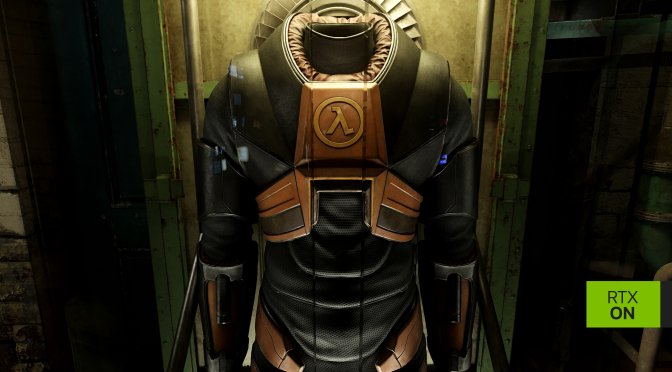Orbifold Studios will release the demo for Half-Life 2 RTX later today. NVIDIA has provided us with a preview code, so it’s time to benchmark it and examine its performance on the PC.
For our benchmarks, we used an AMD Ryzen 9 7950X3D, 32GB of DDR5 at 6000Mhz, AMD’s Radeon RX 6900XT, RX 7900XTX, RX 9070XT, as well as NVIDIA’s RTX 2080Ti, RTX 3080, RTX 4090, RTX 5080 and RTX 5090. We also used Windows 10 64-bit, the GeForce 572.70, and the Radeon Adrenalin Edition 25.3.1 drivers. And yes, you read that right. We have bought an AMD Radeon RX 9070XT.
Half-Life 2 RTX does not have a built-in benchmark tool. So, for our tests, I used the following scene. This scene has a lot of volumetric effects, and it’s the most demanding area I could find.
Half-Life 2 RTX uses Full Ray Tracing/Path Tracing, and comes with new 3D models. And, to play at native 1080p, you’ll need an NVIDIA RTX 5090. As for native 1440p, there is no GPU that can run the demo smoothly.
These results shouldn’t come as a surprise. Half-Life 2 RTX with its new lighting system and its new materials looks as good as modern-day titles. Contrary to Quake 2 RTX, Half-Life 2 RTX has higher-quality textures and more detailed 3D objects/items/characters. I cannot stress enough how good the demo looks.
Half-Life 2 RTX supports DLSS 4, but there is no support for AMD FSR 3.0 or Intel XeSS. That’s a bummer as AMD users won’t be able to enjoy it unless they mod the demo to replace DLSS with FSR.
With DLSS 4 Performance Mode (no Frame Gen), the RTX 5090 can provide a smooth gaming experience, even at 4K. Yes, there were some drops to 54FPS. As I said, though, this is the most demanding area. Other areas run way better than it. Plus, those with a G-Sync monitor won’t really notice these framerate drops.
What’s interesting here is that DLSS 4 Performance Mode provides a BETTER image at 1080p. This is thanks to the Transformer Model. This is the first time I’ve seen DLSS 4 perform THAT well in such a low resolution.
For the best gaming experience at 4K, I highly recommend using DLSS 4 Performance Mode with Frame Gen. With DLSS 4 Performance Mode and MFG X2, the RTX 5090 was able to push framerates over 98FPS. And, since the base framerate was quite high, I did not experience any major input latency issues.
I’ve also tried MFG X3 and X4. And, to be honest, I wasn’t that impressed by them. Both of them introduced a lot of visual artifacts. Speaking of visual artifacts, there are also some with MFG X2. However, they were not THAT distracting. With MFG X3 and X4, things go downhill pretty quickly. And that’s with a pretty good base framerate. I can’t imagine the visual artifacts that you’ll get with a base framerate of 30FPS or 40FPS. So, right now, I don’t recommend using it, even if you own a 240Hz monitor.
Graphics-wise, Half-Life 2 RTX is among the best looking games on PC. Everything looks top-notch. From the lighting to reflections, shadows, and objects; everything looks amazing. This right here shows how transformative RTX Remix can be. I know some of you have been disappointed by some of the RTX Remix Mods I’ve shared. However, Half-Life 2 RTX is incredible.
And there you have it. Half-Life 2 RTX Demo is a graphical showcase on PC. Yes, you’ll need a high-end GPU. However, keep in mind that we’re talking about real-time Path Tracing. Plus, it looks unbelievably beautiful. So yes, it more than justifies its high GPU requirements.
Enjoy and stay tuned for more!

John is the founder and Editor in Chief at DSOGaming. He is a PC gaming fan and highly supports the modding and indie communities. Before creating DSOGaming, John worked on numerous gaming websites. While he is a die-hard PC gamer, his gaming roots can be found on consoles. John loved – and still does – the 16-bit consoles, and considers SNES to be one of the best consoles. Still, the PC platform won him over consoles. That was mainly due to 3DFX and its iconic dedicated 3D accelerator graphics card, Voodoo 2. John has also written a higher degree thesis on the “The Evolution of PC graphics cards.”
Contact: Email







